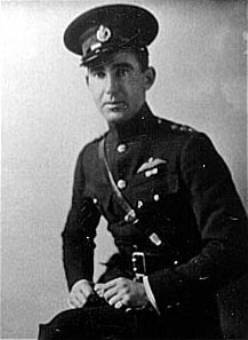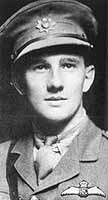Related Research Articles

Between 1911 and 1914, the Royal Aircraft Factory used the F.E.2 designation for three quite different aircraft that shared only a common "Farman" pusher biplane layout.

Captain Frederick Libby became the first American flying ace, while serving as an observer in the Royal Flying Corps during World War I.
Captain Frederick James Harry Thayre was a British two-seater flying ace in World War I who, in conjunction with his observer-gunners, was credited with twenty aerial victories.
Captain Samuel Frederick Henry "Siffy" Thompson was a British World War I two-seater fighter ace who, in conjunction with his observer-gunners, was credited with thirty aerial victories before being shot down and killed. Despite having an active fighter career of only five months, he reached the rank of captain and won two British military decorations.
Captain Dennis Latimer was a British World War I flying ace notable for achieving twenty-eight aerial victories, all against enemy fighter aircraft.
Captain Harry George Ernest Luchford was an English World War I pilot credited with 24 victories. He was notable for scoring his first 11 victories in three months while piloting an obsolete double-seated FE.2 pusher aircraft.
Captain Francis Richard Cubbon was an aerial observer and flying ace in the First World War. In conjunction with his pilots, he was credited with 21 aerial victories.
Lieutenant Llewelyn Crichton Davies was a Welsh World War I flying ace credited with five aerial victories.
Major Stephen William Price was a British World War I flying ace credited with seven aerial victories.
John J. Cowell, was an Irish soldier, airman and flying ace of the First World War. He was credited with sixteen aerial victories; fifteen of these were gained as an observer/gunner and one as a pilot, before he was killed in action.
Sergeant Frank Johnson was a World War I flying ace credited with 16 aerial victories. He flew as both an observer/gunner and as a pilot, and is the only enlisted man to receive a second award of the Distinguished Conduct Medal.
Flight Lieutenant David Arthur Stewart, was a British First World War flying ace credited with sixteen aerial victories. Remarkably, they were all scored while he was flying bombers instead of fighters.
Sergeant Ernest Arthur Deighton was an English World War I observer/gunner flying ace credited with 15 confirmed aerial victories; all but one of them was against enemy fighters.
Lieutenant Reginald Milburn Makepeace was a British World War I flying ace credited with 17 aerial victories.
Lieutenant Cecil Roy Richards was an Australian flying ace of World War I. He was credited with twelve aerial victories.

Flight Lieutenant Robert Leslie Chidlaw-Roberts was a British World War I flying ace credited with ten aerial victories. During his aerial combat career, and in different dogfights, he engaged two famous German aces; he was one of the British pilots who downed Werner Voss, and on 9 January 1918, he shot down and killed Max Ritter von Müller.
Captain Lancelot Lytton Richardson was an Australian flying ace during World War I. He was credited with seven confirmed aerial victories before his death in action on 13 April 1917.
Second Lieutenant Leslie Simpson Court was a British World War I flying ace. He was credited with eight aerial victories, gained while serving as an observer/gunner in No. 25 Squadron, Royal Flying Corps.
Sergeant James McKinley Hargreaves was a Scottish World War I flying ace. Despite being an observer, he became one of the first flying aces in history while flying with Lionel Rees,.
Captain Reginald George Malcolm was a Canadian flying ace during World War I. He was credited with eight aerial victories scored during March, April, and May 1916.
References
- 1 2 "Leonard Herbert Emsden". The Aerodrome. 2014. Retrieved 30 November 2014.
- ↑ http://www.raylong.plus.com/monique/d255.html#P36774 Retrieved 27 November 2011. Archived 26 April 2012 at the Wayback Machine
- ↑ http://www.raylong.plus.com/monique/d285.html#P36663 Retrieved 27 November 2011. Archived 26 April 2012 at the Wayback Machine
- ↑ Shropshire Star. 3 November 2000.
{{cite news}}: Missing or empty|title=(help) - 1 2 3 4 Franks et.al. (1997), p.85.
- ↑ Libby (2000), pp. 136–137.
- ↑ Guttman & Dempsey (2009), p.71.
- ↑ "No. 30135". The London Gazette (Supplement). 18 June 1917. p. 6009.